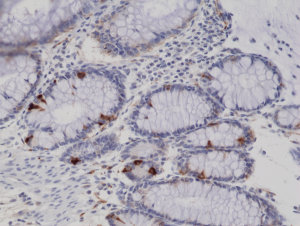anti-Synaptophysin (human) Rabbit Monoclonal (RM258)
| Code | Size | Price |
|---|
| REV-31-1139-00-R100 | 100 ul | £455.00 |
Quantity:
Prices exclude any Taxes / VAT
Overview
Antibody Isotype: Rabbit IgG
Antibody Clonality: Recombinant Antibody
Antibody Clone: RM258
Regulatory Status: RUO
Target Species: Human
Applications:
- Immunohistochemistry (IHC)
- Western Blot (WB)
Shipping:
Blue Ice
Storage:
+4°C
Images
Documents
Further Information
Alternate Names/Synonyms:
Major Synaptic Vesicle Protein p38
Concentration:
N/A
EClass:
32160000
Form (Short):
liquid
Formulation:
Liquid. 50% Glycerol/PBS with 1% BSA and 0.09% sodium azide.
Handling Advice:
Avoid freeze/thaw cycles.
Immunogen:
A peptide corresponding to the C-terminus of Synaptophysin.
Long Description:
Recombinant Antibody. This antibody reacts to human Synaptophysin. Applications: WB, IHC. Source: Rabbit. Liquid. 50% Glycerol/PBS with 1% BSA and 0.09% sodium azide. Synaptophysin (major synaptic vesicle protein p38) is a calcium-binding and integral membrane glycoprotein present in presynaptic vesicles in almost all neurons. Synaptophysin has four transmembrane domains and it forms a complex with dynamin at high calcium concentrations suggesting an involvement in synaptic vesicle endocytosis. It is also involved in the regulation of short-term and long-term synaptic plasticity. Synaptophysin is currently the most widely used marker for nerve terminals and for differentiating neuroendocrine tumors and its ubiquity at the synapse has led to the use of synaptophysin immunostaining for quantification of synapses. Mutations in the gene can result in mental retardation, increased exploratory behavior, impaired object novelty recognition and reduced spatial learning. Using immunohistochemistry, synaptophysin can be demonstrated in a range of neural and neuroendocrine tissues, including cells of the adrenal medulla and pancreatic islets. As a specific marker for these tissues, it can be used to identify tumours arising from them, such as neuroblastoma, retinoblastoma, phaeochromocytoma, carcinoid, small-cell carcinoma, medulloblastoma and medullary thyroid carcinoma.
NCBI, Uniprot Number:
P08247
Package Type:
Vial
Product Description:
Synaptophysin (major synaptic vesicle protein p38) is a calcium-binding and integral membrane glycoprotein present in presynaptic vesicles in almost all neurons. Synaptophysin has four transmembrane domains and it forms a complex with dynamin at high calcium concentrations suggesting an involvement in synaptic vesicle endocytosis. It is also involved in the regulation of short-term and long-term synaptic plasticity. Synaptophysin is currently the most widely used marker for nerve terminals and for differentiating neuroendocrine tumors and its ubiquity at the synapse has led to the use of synaptophysin immunostaining for quantification of synapses. Mutations in the gene can result in mental retardation, increased exploratory behavior, impaired object novelty recognition and reduced spatial learning. Using immunohistochemistry, synaptophysin can be demonstrated in a range of neural and neuroendocrine tissues, including cells of the adrenal medulla and pancreatic islets. As a specific marker for these tissues, it can be used to identify tumours arising from them, such as neuroblastoma, retinoblastoma, phaeochromocytoma, carcinoid, small-cell carcinoma, medulloblastoma and medullary thyroid carcinoma.
Purity:
Protein A purified.
Source / Host:
Rabbit
Specificity:
This antibody reacts to human Synaptophysin.
Transportation:
Non-hazardous
UNSPSC Category:
Primary Antibodies
UNSPSC Number:
12352203
Use & Stability:
Stable for at least 1 year after receipt when stored at -20°C.



